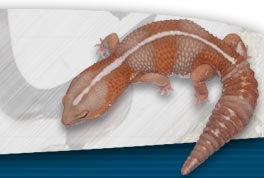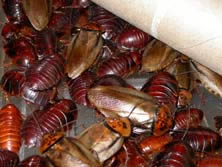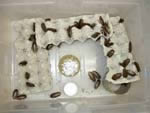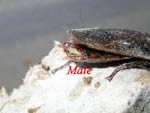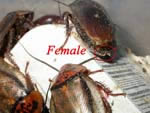

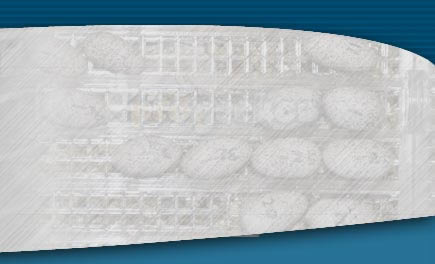

General Information:
Orange head roaches (Eublaberus prosticus) are a tropical roach from South America. They measure around 2 inches in length as adults and are around 1/4 inch in length when born. Adults have wings but are unable to fly. This is a non-climbing species which means they are unable to climb smooth surfaces. They are a nocturnal species being more active at night and are very shy and skittish when disturbed. Adults have a life span of around 1 year.Housing:
Housing orange heads is very simple. Any container is suitable to use such as but not limited to Rubbermaid containers or glass aquariums. Size does not really matter but will depend on how many roaches you need to keep. I use a 56 quart Rubbermaid for mine. Another thing to keep in mind is to never overcrowd the container. A for sure sign of this would be short or missing antennas. Overcrowding can also slow production and growth because of the competition for food and hiding areas.Substrate - I suggest not using any type of substrate to minimize maintenance. This will make cleaning much easier and greatly decrease any smell.
Hides - Provide plenty of hiding places. This can be achieved by placing several egg cartons, paper towel rolls or toilet paper rolls in the cage. This will let them hide and feel more comfortable. Hiding places are essential for the colony to thrive and to minimize overcrowding.
Heat & Light - Orange heads are nocturnal therefore they should be kept in the darkest area possible where they will be most active. As far as temperatures they like it hot especially for breeding. Ideally keep them around 90 degrees fahrenheit. During the summer my roaches experience temperatures around 105 to 110 degrees fahrenheitand this is when production and growth is highest. Remember when they are at these extreme temperatures they’ll eat more and need more water to stay hydrated. If they are producing faster than you wish you can bring their temperatures down to 75 degrees fahrenheit. They will still thrive but grow and reproduce slower.
Food & Water:
Like all roaches orange heads will eat just about anything they are offered. Highly nutritious items such as various fruits, vegetables, grains etc. are all accepted and remember variety is key. Orange heads should have more protein in their diet over other roaches. A sign of not enough protein would be seeing bitten wing tips. Make sure to gutload all food items for 24 hours prior to feeding. Gutloading is feeding very nutritious/high quality foods (such as the ones listed above) to prey prior to feeding to your animals. There are also many commercially available products that are in powder form. I make and use Pro Gutload for all my feeders. Gutloading will ensure a healthier insect and in the long run a healthier animal.Water - I offer a shallow dish of water and keep it full at all times. If you are experiencing drownings a sponge or paper towel may be added to the dish to prevent this issue. This should be cleaned several times a week to prevent bacteria build up and replaced with fresh water. You can also use water gel, fruits and vegetables as a water source.
Maintenance:
Maintenance is minimal when keeping any species of roach. Depending on the amount of roaches you have in a container they should be cleaned on at least a monthly basis but I prefer to do it weekly. This can be done by sifting the roaches from the waste or with a brush and scoop. Orange heads do give off a defensive odor when disturbed and with the combination of waste can make the smell more intense. Regular cleaning will reduce smell and the potential for bacteria build up. Also make sure they have fresh clean water and food at all times. Every few weeks to a month change the egg cartons.Breeding:
Roaches are probably the easiest creature in the world to breed. All they really need is suitable housing, food, water and heat. With time and patients you can build up to an endless supply of food.Sexing - Males are generally smaller with females being much wider and thicker. The easiest and most effective way to sex them is by looking near the tip of the abdomen. Males have a white spot while the same region on females is the same color as their body.
Breeding - The roaches mature at 3 to 4 months of age depending on temperature. This is the stage where they can start reproducing. Place your mature roaches in a container and wait. Soon you will see the females getting larger. You might even witness a female extracting their egg case called an ootheca. Do not disturb them when they are doing this! If disturbed you may loose the babies. Once the egg case is extracted the female then retracts it back inside a special cavity. This is where the babies develop and the female gives birth to 20 to 30 live babies after about a month gestation. The best part about orange heads is they give live birth so no incubation is needed.
As a feeder - Roaches make excellent feeders for your reptiles. They are high in protein and have a good shell to meat ratio. Animals will readily take them. Because these roaches are a non-climber there is no need to worry about them escaping.
Conclusion:
Orange heads have steadily gained in popularity as a feeder. They are very easy to care for, are non-climbers and they produce well. I’ve found they are the fastest producing of the non-climbing species which sets them apart. Orange heads are nice because they are packed with protein. If you want an easy to care for roach and an endless supply of food orange heads may just be for you.

